Peanut Crop Short And Cheap Thanks To 2012's Historic Yields

Prices for the 2013 peanut crop have been dropping steadily since July, with farmers recently reporting stock prices that average about 24.1 cents per pound—a 24 percent drop from last September.
More than 6 billion pounds of peanuts came out of 2012’s record-breaking harvest, an 84 percent increase from 2011. Farmers are still trying to unload more than a million tons they have from last year.
In an attempt to remedy that peanut hangover, farmers are swapping out peanuts for more stable crops like corn, soybeans and cotton. Corn production is expected to hit its third-highest yield on record, said the USDA, and farmers have planted the second-largest soybean acreage on record this year.
A heavy peanut supply coupled with stagnant demand means many manufacturers aren't doling out attractive contracts. Pair that with a finicky, sensitive crop that needs specific conditions to thrive and you have a roller coaster market that has farmers making some abnormal planting decisions.
"It's almost as if the bottom has fallen out of the peanut market," said Mike Olsen, a peanut farmer in Southwest Oklahoma.
Olsen told the Southwest Oklahoma News that he decided to plant less than usual because prices were down across the board at the market, but an unpredicted drought may make his crop worth even less.
Experts say that since peanut acreage is market-driven and inconsistent, farmers have decided to steer away from a typical three-year crop rotation cycle.
Georgia and Alabama make up more than 50 percent of the nation’s peanut production, and this year those farmers weren’t afraid to snub the crop, planting 25 percent to 30 percent fewer peanuts than they usually do in a typical three-year rotation cycle, because they expected to lose money on a crop that was garnering unacceptably low contract offers.
“There were barely any [contract] offerings at the time when farmers planted,” said Don Koehler, the executive director of the Georgia Peanut Commission. “Peanuts have no futures market, so if farmers aren’t contracted to plant peanuts, there won’t be any peanuts. Crops compete for dirt.”
Georgia Farmers planted nearly 300,000 fewer acres of peanuts this year, totaling about 426,000. That’s quite a drop from the 730,000 acres planted in 2012, says Koehler, who said Georgia would churn out about 43 percent fewer peanuts because of last year’s over-production.
“Our peanut crop in Georgia right now is like that Clint Eastwood movie,” said Koehler. “Good, bad and ugly.”
Bugs, disease, torrential rains, heat spells and low-ball contract offers have decimated the state’s crop, and since farmers already decided to plant far less than normal, it’s hard to tell what the state’s yield will actually be.
Not to mention farmers had little price incentive to stick with the nut.
As of Sept, 11, 2013, farmers were being offered about $460 per ton for runner peanuts, which is the type of peanut used to make peanut butter, almost $100 less per ton than last year.
“That price is too low for farmers to sustain peanut production,” said Koehler. “It would start costing them money and farmers have to pay their bills at the end of the day.”
As a result, Koehler says Georgia went “really heavy on corn this year because the price for corn was fair and peanut prices weren’t.”
Alabama’s peanut production also took a significant hit due to an unlucky combination of an extremely wet summer and last year’s over supply.
“Overall, our peanut production is projected to be down 55 percent,” reported Alabama Governor Robert Bentley.
According to the USDA’s August Crop Production Report, Alabama planted about 90,000 less acres than it did in 2012.
Kris Balkcom, who is the Auburn University Extension peanut specialist, says a small peanut crop can change the face Alabama farming year-to-year.
“It’s a mixed bag out there with peanuts this year, nothing like corn and soybeans, which we grow several million acres of,” said Balkcom. “Because peanuts aren’t traded like corn is.”
Despite the highs and lows, peanut acreage numbers still look promising and could lead to a market resurge. Especially if peanut prices are too low for farmers to plant, manufacturers will be forced to start shelling out contracts and pay higher prices to prevent potential future shortage. However, Balkcom says farmers will most likely have to wait until winter to judge the direction of the crop . It’s just another bump in the ride.
“I anticipate that we will see an increase for 2014 crop in farmer stock prices,” said Koehler. “You can’t keep the level of acres as low as they are and still give consumers what they want.”



